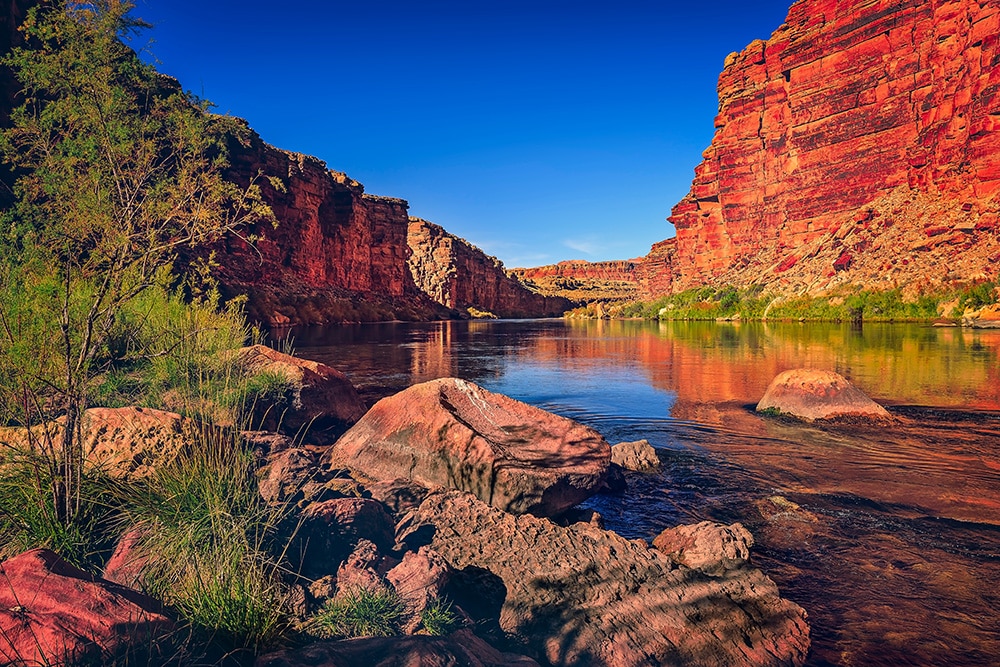The Colorado River loses 19.3 million acre feet of water per year to cities, farms and evaporation—roughly the amount of water used by the 50 largest U.S. cities each year. This loss now exceeds water added to the river by the water cycle, resulting in a shortage of water, which triggered a formal declaration of a Tier 1 water shortage beginning in 2021—along with cuts in water deliveries, especially to farmers in the state of Arizona.
Stabilizing this icon of the American West is possible, according to a study published today in Nature Communications Earth & Environment, but it will require significant reductions in water use, especially from the irrigated agriculture industry. This new accounting of water use in the Colorado River Basin shows that almost half of water consumed in this region in the last two decades goes to cattle-feed crops such as alfalfa and grass hay.
The findings provide an authoritative update to results from a widely publicized 2020 study published in Nature Sustainability. This new publication, led by Brian Richter of Sustainable Waters, includes three researchers at Northern Arizona University with the FEWSION Project: postdoctoral scholar Laljeet Singh Sangha, assistant research professor Richard Rushforth and professor Benjamin Ruddell in the School of Informatics, Computing, and Cyber Systems (SICCS).
Given how complicated water consumption in the Colorado River basin is, the NAU team had to undertake an exhaustive process to document monthly Central Arizona Project deliveries back to 2000 to track the final use of the water, whether agricultural, municipal and industrial, or transferred between different types of water users through various agreements.
“This research is a result of an exhaustive process of incorporating as much of the known, publicly available data on the who, what, why and how Colorado River water is consumed across the basin,” Rushforth said. “Given the state of the reconsultation of Colorado River allocations, this work has the potential to inform the future of the river basin.”
The data showed:
- Agriculture is the dominant use of Colorado River water; irrigated agriculture accounted for 52% of overall use and 74% of direct human consumption. This represents a modest reduction from estimates published in 2020.
- Cattle-feed crops such as irrigated hay and alfalfa are the dominant water-consuming crops, accounting for 62% of all Colorado River agricultural water consumed.
- Cattle-feed crops consume 90% of all water used by irrigated agriculture within the Upper Basin, above Lake Powell.
Understanding where this water is going is critical right now, as multiple legal agreements intended to temporarily reduce water use expire in 2026. As states, tribes and countries renegotiate those deals, they need authoritative and independent scientific information on how the river’s water is used.
“The Biden Administration’s draft plan released in early March 2024 calls for three million acre feet per year in cuts by 2026,” Ruddell said. “Based on this new paper’s findings, this draft plan is likely to succeed in stabilizing the Colorado River and its two major reservoirs, but only if the plan is implemented quickly enough. Implementation before the summer growing season of 2024 would be better.”
The researchers gathered data from 2000-2019, estimating the balance of water removed from the river by people, ecosystems and evaporation. The data sources include the U.S. Bureau of Reclamation, the Central Arizona Project, Arizona Department of Water Resources and a variety of prior scientific studies.
The numbers presented in this study demonstrate that stabilizing the Colorado River is possible, but it will require significant reductions in water use. A reduction of 2.4-3.2 million acre feet per year or roughly 17% should stabilize reservoir levels in 2024. By 2050, that reduction may need to be doubled to roughly 33% from current usage as a warmer climate reduces snowmelt and other water supplied to the Colorado River.
For perspective, the reduction needed this year is similar to the State of Arizona’s entire allocation, and in 2050 the reduction needed may be roughly equivalent to the Lower Basin’s entire allocation—illustrating that this is not a problem that can be solved by one state or irrigation district alone, nor by the Lower Basin without the Upper Basin.
The entire reduction in water use needed to stabilize the Colorado River could be achieved by reducing irrigated agricultural water deliveries and investing in improved irrigation efficiency. More than half of the irrigated agricultural production in the Basin can probably be preserved for the long term. Of course, added investment in water conservation in cities will also help—but city water conservation is not enough to solve the problem without large agricultural cuts.
The 2020 Richter et al. study in Nature Sustainability argued that voluntary and auction-priced rotational fallowing programs are an effective mechanism for agricultural water use reduction, by arranging for cities to pay farmers to temporarily reduce water use during dry years. This mechanism minimizes the cost of the water cuts to taxpayers and mitigates the financial impact on farmers.
The research was funded in part through NSF on the Transformation Network SRS-RN (NSF CBET #2115169).

(928) 523-8737 | heidi.toth@nau.edu



